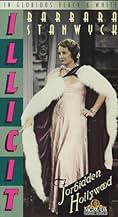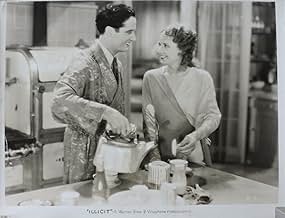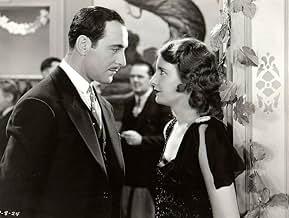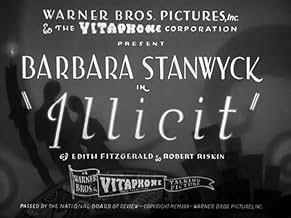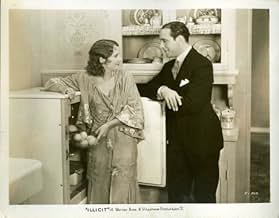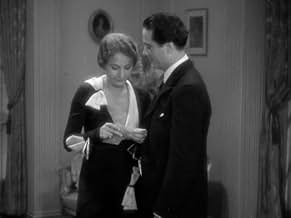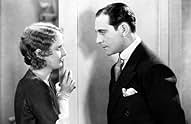VALUTAZIONE IMDb
6,1/10
1250
LA TUA VALUTAZIONE
Una giovane coppia vive insieme fuori dal matrimonio, ma scopre di essere in anticipo sui tempi.Una giovane coppia vive insieme fuori dal matrimonio, ma scopre di essere in anticipo sui tempi.Una giovane coppia vive insieme fuori dal matrimonio, ma scopre di essere in anticipo sui tempi.
- Regia
- Sceneggiatura
- Star
- Premi
- 2 vittorie totali
Hazel Howell
- Girl at the Bridal Shower
- (non citato nei titoli originali)
Lucille Ward
- Susan - Anne's Maid
- (non citato nei titoli originali)
Barbara Weeks
- Girl at the Bridal Shower
- (non citato nei titoli originali)
Recensioni in evidenza
The best part of this rather boring gabfest is getting to see ladies high-fashion outfits, circa 1930. Some of them are real doozies. Stanwyck gets more than her share of slinky finery as a rich guy's paramour. Actually, the movie's premise is a significant one—does marriage somehow kill love? Anne (Stanwyck) seems to think so and sometimes acts on the premise. The trouble is that the premise gets drowned out by all the talk from one scene to the next, without let-up. Then too, director Mayo adds nothing to what turns out to be a filmed stage play. To be charitable, his options may have been cramped by the newness of movie sound equipment.
Pre-Code liberties are evident in the first few scenes where Anne, in a clinging negligee, and Dick (Rennie) discuss whether to marry or to continue living in sin. After that, the screenplay settles into more conventional marital mix-ups. But at least Stanwyck shines, showing why she was slated for bigger and better things. In fact, she's almost girlish, a really long way from the femme fatale of Double Indemnity (1944). Too bad she doesn't have more scenes with that other Warner's personality girl, Joan Blondell (Duckie). Anyway, I found the movie considerably less than I expected.
Pre-Code liberties are evident in the first few scenes where Anne, in a clinging negligee, and Dick (Rennie) discuss whether to marry or to continue living in sin. After that, the screenplay settles into more conventional marital mix-ups. But at least Stanwyck shines, showing why she was slated for bigger and better things. In fact, she's almost girlish, a really long way from the femme fatale of Double Indemnity (1944). Too bad she doesn't have more scenes with that other Warner's personality girl, Joan Blondell (Duckie). Anyway, I found the movie considerably less than I expected.
This movie creaks with age, but is memorable for being Barbara Stanwyck's first movie as a star. Miss Stanwyck gives an excellent performance, as always, but the supporting cast, particularly Charles Butterworth, steals the show as an amiable drunk whose bark is worse than his bite.
Am somebody that doesn't mind in any way melodrama, and there are many great ones from the classic film era (name from the 40s and 50s), as long as the film in question is done well. The story sounded really good on paper, even if it is melodramatic personified, and have always loved Barbars Stanwyck as an actress. When it came to melodrama during the "classic film" era, she was one of the greats when it came to actresses, Joan Crawford was another good example.
'Illicit', a very early film for Stanwyck, has been inevitably compared to its "remake" made two years later 'Ex-Lady'. It is not very often where there has been personal preferences for remakes over their originals (David Cronenberg's 'The Fly', from personal opinion, is one of the finest examples of preferring the remake over the original), but to me 'Ex-Lady' is the better film. Found it to be wittier, more daring, that it didn't take itself as seriously and that it has held up better. Am not saying by any stretch that 'Illicit' is a bad film, it isn't and it is definitely worth a look if only once perhaps but that is dependent on one's taste. It is namely to be seen if you want to see Stanwyck in an early role pre-stardom and if you want to see every film of hers in existence.
There are good things here. It is nicely photographed and the period detail in all senses is truly opulent. Absolutely love Stanwyck's clothes and she looks great in them. There are some amusing and moving moments.
Most of my mixed feelings rating though is for the acting, which, excepting a bland and quite stiff James Rennie in a nothing role, is very good. Stanwyck is wonderful with all the things that made her a great actress at her peak emerging here and the main reason to see 'Illicit' (will confess to having to give it less than a 5 if she wasn't as good as she was). Charles Butterworth is the other standout and is an amusing presence, and Joan Blondell is always worth watching. Ricardo Cortez is fine too.
Unfortunately, 'Illicit' comes over as very creaky and stage bound today. Or at least that's my perspective. The pace can be quite dreary and the drama that the quite thin story has feels too much of a very over-heated (a danger with melodrama) filmed play. 'Illicit' has more of a serious tone compared to 'Ex-Lady', so serious that it comes over as a little too glum in places. The sound is quite primitive and has an awkward flow at times.
Did find 'Ex-Lady' (really sorry for the comparison) to be better scripted, just preferred the wittier tone and the tauter pace of it and also found it more daring as said. Anything that may have shocked in 'Illicit' back then is reasonably tame now, whereas you could see much better how 'Ex-Lady' was ahead of its time. Although the acting is good, as said Rennie fails to make much of an impression and a large part of it is down to that his character is very sketchy.
All in all, worth a look but a bit of an oddity. 5/10
'Illicit', a very early film for Stanwyck, has been inevitably compared to its "remake" made two years later 'Ex-Lady'. It is not very often where there has been personal preferences for remakes over their originals (David Cronenberg's 'The Fly', from personal opinion, is one of the finest examples of preferring the remake over the original), but to me 'Ex-Lady' is the better film. Found it to be wittier, more daring, that it didn't take itself as seriously and that it has held up better. Am not saying by any stretch that 'Illicit' is a bad film, it isn't and it is definitely worth a look if only once perhaps but that is dependent on one's taste. It is namely to be seen if you want to see Stanwyck in an early role pre-stardom and if you want to see every film of hers in existence.
There are good things here. It is nicely photographed and the period detail in all senses is truly opulent. Absolutely love Stanwyck's clothes and she looks great in them. There are some amusing and moving moments.
Most of my mixed feelings rating though is for the acting, which, excepting a bland and quite stiff James Rennie in a nothing role, is very good. Stanwyck is wonderful with all the things that made her a great actress at her peak emerging here and the main reason to see 'Illicit' (will confess to having to give it less than a 5 if she wasn't as good as she was). Charles Butterworth is the other standout and is an amusing presence, and Joan Blondell is always worth watching. Ricardo Cortez is fine too.
Unfortunately, 'Illicit' comes over as very creaky and stage bound today. Or at least that's my perspective. The pace can be quite dreary and the drama that the quite thin story has feels too much of a very over-heated (a danger with melodrama) filmed play. 'Illicit' has more of a serious tone compared to 'Ex-Lady', so serious that it comes over as a little too glum in places. The sound is quite primitive and has an awkward flow at times.
Did find 'Ex-Lady' (really sorry for the comparison) to be better scripted, just preferred the wittier tone and the tauter pace of it and also found it more daring as said. Anything that may have shocked in 'Illicit' back then is reasonably tame now, whereas you could see much better how 'Ex-Lady' was ahead of its time. Although the acting is good, as said Rennie fails to make much of an impression and a large part of it is down to that his character is very sketchy.
All in all, worth a look but a bit of an oddity. 5/10
The naming of this film must have been just to attract Depression era audiences, because there is nothing really illicit about it. However, it is a very modern look at romance and marriage considering it was made in 1931. Barbara Stanwyck plays Anne Vincent, a modern woman who is afraid that her relationship with boyfriend Richard Ives will be changed by marriage. She bases her beliefs on watching her own parents and her friends. In her parents' case she says that she knows they loved each other, but divorced anyways, and she is sure that separation from one another is what killed them. However, social pressures prevail and the two do get married.
Anne's fears become realized as Richard seems to only be interested in going out when it involves other people, not just Anne. She sees him out with another woman one night when he is supposed to be working, and she decides what the two need is a trial separation from one another - to become individuals again. Throw Ricardo Cortez into the mix as someone who wants Anne's marriage to not work out, and you have the makings of an above average potboiler from the precode era.
This film is mainly interesting because of Stanwyck. Without her abilities this would be a pretty forgettable film. And those fashions! With all of the ermine and feathers, this film has Barbara Stanwyck venturing into Kay Francis territory. Also lending good support is Charles Butterworth as the seldom sober friend to the young couple, and the always wonderful Joan Blondell as Anne's close friend.
Anne's fears become realized as Richard seems to only be interested in going out when it involves other people, not just Anne. She sees him out with another woman one night when he is supposed to be working, and she decides what the two need is a trial separation from one another - to become individuals again. Throw Ricardo Cortez into the mix as someone who wants Anne's marriage to not work out, and you have the makings of an above average potboiler from the precode era.
This film is mainly interesting because of Stanwyck. Without her abilities this would be a pretty forgettable film. And those fashions! With all of the ermine and feathers, this film has Barbara Stanwyck venturing into Kay Francis territory. Also lending good support is Charles Butterworth as the seldom sober friend to the young couple, and the always wonderful Joan Blondell as Anne's close friend.
Barbara Stanwyck and James Rennie are ultra-modern 1930s lovers who shun conventional trappings such as marriage. She is afraid that marriage will kill the romance. Who has not had these fears? He is eternally patient, but his father maneuvers her into a commitment. Their marriage stumbles (whose hasn't) and the ex-girlfriend and ex-boyfriend enter the scene. Soon this thoroughly modern couple are acting like typical married folk and Barbara declares that the marriage has indeed killed the love. Stanwyck exhibits skills as an actress that will make her famous in better films later. Claude Gillingwater's portrayal of the father is excellent and serve as a good role model. Charles Butterworth (the faithful friend) was really quite a wit and succeeds in stealing a scene or two. I can overlook any technical flaws in the movie because I think that the central issues are still relevant today. Who has to compromise more in a marriage? The husband or the wife? Will each of the lovers do what is necessary to save the marriage when they know they have problems? All is not revealed until the final scene whose outcome is by no means certain. Good movie, not a great one, but good entertainment for a couple that talk to each other. I say watch it (if you can find it) and see if this pre-Code movie does not warrant your appreciation and was worth your time.
Lo sapevi?
- QuizOn the phone, Dick and Anne tease Duckie that they can't agree on which vacuum cleaner to buy, a Peerless or a General Electric. The joke here appears to be that Peerless was an old maker of hand-pump vacuums, never electric ones.
- Blooper(at around 5 mins) As Dick and Anne are walking out of the kitchen, a moving shadow of the boom microphone is visible on the wall to the left.
- Citazioni
Richard 'Dick' Ives II: Dad, what would you do with a girl like that?
Richard Ives Sr.: I'd grab her any way she'd have me.
- ConnessioniFeatured in Sex, Censorship and the Silver Screen: The Temptations of Eve (1996)
- Colonne sonoreMaybe It's Love
(1930) (uncredited)
Music by George W. Meyer
Lyrics by Sidney D. Mitchell and Archie Gottler
Whistled by James Rennie
Hummed and sung by Barbara Stanwyck
I più visti
Accedi per valutare e creare un elenco di titoli salvati per ottenere consigli personalizzati
- How long is Illicit?Powered by Alexa
Dettagli
- Data di uscita
- Paese di origine
- Lingua
- Celebre anche come
- Lo ilícito
- Luoghi delle riprese
- Azienda produttrice
- Vedi altri crediti dell’azienda su IMDbPro
Botteghino
- Budget
- 249.000 USD (previsto)
- Tempo di esecuzione1 ora 19 minuti
- Colore
Contribuisci a questa pagina
Suggerisci una modifica o aggiungi i contenuti mancanti


